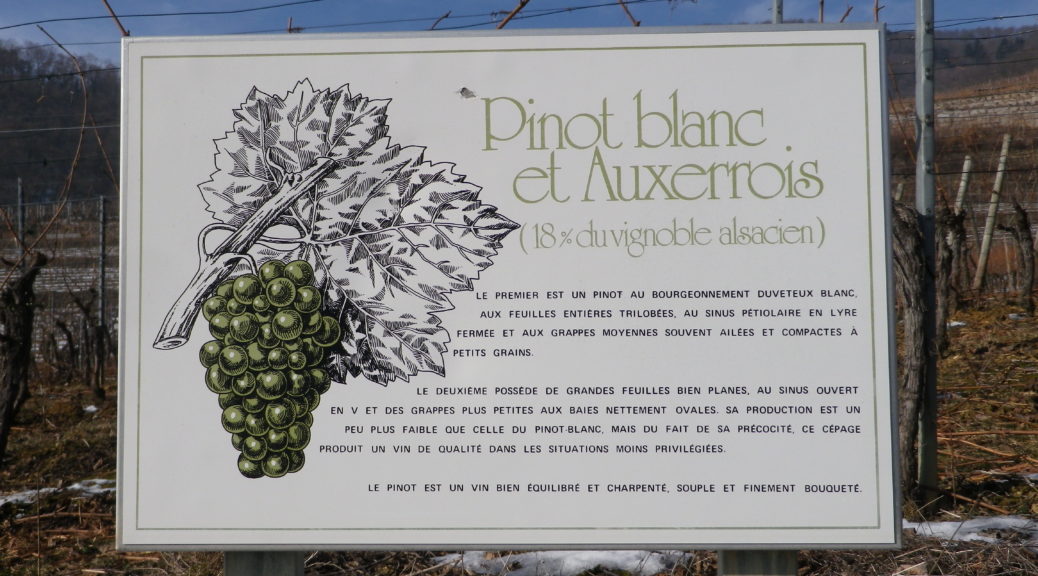What I Learned
Alsace’s Haut-Rhin (upper Rhine) area’s interesting geological history resulted in some great terroirs. It was initially born of volcanic activity. Once spent, the volcanic mountains collapsed on themselves, and an ancient sea covered the area. Then two roughly parallel mountain chains arose (the Vosges in France, and the Black Forest range in Germany), and the ancient Rhine river poured through the resulting valley. As the river receded to its current banks, it exposed the slopes of the Vosges. The soil here is incredibly complex, thanks to this geological history, and it results in minerally, and complex wines.
Alsatian wine classifications are similar to that of Burgundy with Grands Crus at the top of the quality spectrum, and Appellation Alsace Controlee for just about everything else within specific areas if meeting specific quality regulations. Roughly between Riquewihr and Kaysersberg (and Kientzheim), there are several Grands Crus. Some of these are more reputed than others, and there is talk of establishing some Premiers Crus, to account for these differences.
The Grand Cru Schoenenburg, just north of Riquewihr’s old town walls, is certainly one of Alsace’s great ones. Its renown extends to at least the 17th Century. Its soil is a mix of mineral type and composition, which can account for its wines’ marvelous layers of flavor, in the hands of a good wine-maker. The slope faces south and southeast, giving the grapes great exposure. It is also fairly steep, increasing the vines’ exposure to the sun, and providing good drainage. Riesling is the predominant varietal in this Grand Cru.
South of that is Riquewihr’s Sporen. While it has less of an incline than the Schoenenburg, it faces southeast as well. However, its fame extends even further back in time, although at that time, its acreage was a lot less than it is today. Gewurztraminer and Pinot Gris are the main varietals here.
Just north of Kaysersberg and neighboring Kientzheim is the Grand Cru Schlossberg. Kayersberg means Emperor’s Mountain, and the Schlossberg undoubtedly refers to the emperor’s castle on this hill. The exposure is southern, and the incline rather steep. Vintners cultivate Riesling overwhelmingly in these sun-kissed terraces. While the Grand Cru is officially assigned to Kientzheim (the village just east of Kaysersberg), its vines come right up to Kaysersberg’s town line. This is one of the relatively rare Grand Cru in Alsace with granitic soil. Noted as a viticultural area since at least the 14th Century, it is considered likely that the Romans planted the first vines in this area.
Just across the narrow valley due south of Kientzheim is Ammerschwihr, where the Grand Cru Kaefferkopf lies. Like the Grand Cru Schlossberg it has primarily granitic soil, but there the similarity ends. It was designated a Grand Cru only in 2006. (The first Alsatian Grands Crus were officially designated in 1983.) Planted with a bare majority of Gewurztraminer, Riesling is only the second most planted varietal. And again, unlike the Schlossberg, its orientation is to the east. Wines from here are produced as varietal wines, or as a specific blend. The label on the blend will read “Kaefferkopf” (as opposed to the bottle’s quality designation “Appellation Kaefferkopf Controlee”), and it will consist of a bare majority of Gewurztraminer (40-60%), with 10-40% Riesling, and up to 30% Pinot Gris, if used at all.
Most of the information in this post came from a great resource on Alsatian wines: http://www.vinsalsace.com/fr/grands-crus/pure-expression/
What I Tasted
2015 Pinot Blanc, Cotes de Kaysersberg, Appellation Alsace Controlee, Domaine Bernard Haas & Fils (Kaysersberg): A dry white wine with medium minus gold color; a tart, fruity nose with a whiff of smoke, and peach and green grape flavors with hint of smoke; a tart finish with medium plus acidity.
2014 Gewurztraminer, Grand Cru Kaefferkopf, Appellation Alsace Grand Cru Controlee, Schneider (Ammerschwihr): A dry white wine with medium gold color; a floral nose, reminiscent of roses, and a fruity, lychee-like scent; floral, exotic fruits, and spicy flavors; mild acidity.
2011 Riesling, Grand Cru Schoenenbourg, Appellation Alsace Grand Cru Controlee, Maison Regine Zimmer (Riquewihr): A dry white wine with medium gold color; citrus nose, with mineral, green apple and citrus flavors; high acidity.
2009 Riesling, Grand Cru Schoenenbourg, Appellation Alsace Grand Cru Controlee, Maison Regine Zimmer: A dry white wine with rich medium gold color; nose of melon and honey, with flavors of honey, melon, spice and smoke. This wine had layers of flavors with a medium mouthfeel and medium acidity.
